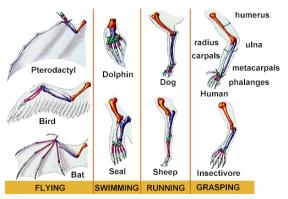Diversity and Adaptation ExplainedDiversity and adaptation are features of our world that demand explanation. The only explanation that is consistent with the range of scientific observations made over the past several hundred years in biology, geology and chemistry is the Theory of Evolution by Natural Selection. This scientific theory was originally formulated in the late 1800's by Charles Darwin and, simultaneously, by Alfred Russell Wallace (for a good description of the historical context within which the ideas about evolution by natural selection were developed, see Futuyma, 1998, Ch. 2). The process of evolution and its basis as an explanation for diversity and adaptation is twofold. First, evolution is a change over time in either the kinds of species present on the Earth, or in their characteristics. Such changes can be clearly documented. For example, some types of organisms present in fossil layers deposited 400 million years ago have never been found in rocks that were formed more recently. In turn, many fossilized forms found in more recent sediments are never seen together with the kinds of fossils found in older sediments. For example, we know from fossil evidence that no humans were alive at the time of the dinosaurs - dinosaurs and humans are never found in rocks of the same age. This is evidence for evolutionary change in the composition of species over time. Secondly, evolution is characterized by descent with modification. This means that organisms that share a common ancestor will be expected to also share many characteristics. During descent, however, variability in characters occurs, and features can (and have) become modified to take on different functions. For example, all life shares a common genetic code. This is powerful evidence that we are all descended from a single common ancestor. However, different organisms have very different genes and/or forms of genes, and these differences in the "instruction manual" are responsible for many of their physical differences. This is descent with modification. A classic example of descent with modification is the observation that all four-legged vertebrates (tetrapods) share common bone types in their limbs. Such bones that are similar because of ancestry are called homologous. Looking at the limbs of tetrapods as different as bats, dolphins, sheep and humans reveals that the striking differences among their limbs have been evolved through modification of the same set of bones into wings, flippers, legs and arms (figure 3 below). This homology of structures with very different functions among organisms due to descent with modification is evidence for evolution. For further evidence of change over time and descent with modification (see the excellent treatment in Ridley, 199x, Chapter 3).
Figure 3. Homologous structures in the tetrapod limb, modified for various functions. Notice that the various bones, which are tinted different colors, have been modified in different ways to accomplish each type of locomotion (e.g., compare the modifications of the bones for flight). From Audesirk/Audesirk, BIOLOGY: Life On Earth, 5/e, © 1999. Electronically reproduced by permission of Pearson Education, Inc., Upper Saddle River, New Jersey. Figure 14-8. Evolution is a fact. We can observe change over time and descent with modification. So why do we call the process that leads to diversity and adaptation the Theory of Evolution by Natural Selection? In science, a theory is "a statement of a natural law... QED". A scientific theory is not just a casual idea, or a set of untested hypotheses, but is instead a well-tested explanation of the natural laws that cause observed facts on Earth. To put the Theory of Evolution by Natural Selection into a context, another scientific theory that we all experience each day is the Theory of Gravitation. This theory explains why my keys fall to the floor when they are dropped. The explanation for the observation that the keys fall is based on well tested and thoroughly substantiated knowledge of the causes (and effects) of gravity on the Earth. The explanation of the observations of change over time and descent with modification in the biological world is the similarly well tested and substantiated Theory of Evolution by Natural Selection. For further discussion on evolution as fact and theory, see Futuyma (1998, Ch. 1).
Contributed by: Dr. Sara Via |






